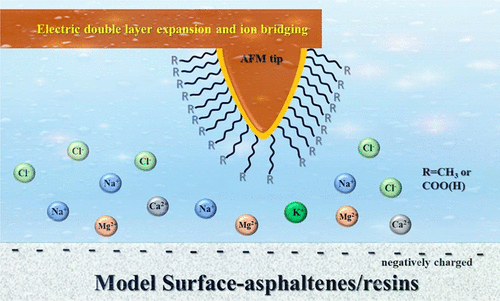当前位置:
X-MOL 学术
›
Energy Fuels
›
论文详情
Our official English website, www.x-mol.net, welcomes your
feedback! (Note: you will need to create a separate account there.)
Insights into the Pore-Scale Mechanism for the Low-Salinity Effect: Implications for Enhanced Oil Recovery
Energy & Fuels ( IF 5.2 ) Pub Date : 2018-11-21 00:00:00 , DOI: 10.1021/acs.energyfuels.8b02322 Z. L. Liu 1 , T. Rios-Carvajal 1 , M. P. Andersson 1 , M. Ceccato 1 , S. L. S. Stipp 1 , T. Hassenkam 1
Energy & Fuels ( IF 5.2 ) Pub Date : 2018-11-21 00:00:00 , DOI: 10.1021/acs.energyfuels.8b02322 Z. L. Liu 1 , T. Rios-Carvajal 1 , M. P. Andersson 1 , M. Ceccato 1 , S. L. S. Stipp 1 , T. Hassenkam 1
Affiliation

|
The properties and behavior of the interface between mineral surfaces, adsorbed organic compounds, and water are important for oil recovery. Low-salinity (LS) water flooding releases more oil from sandstone reservoirs than conventional flooding with seawater or formation water. However, the role of strongly adsorbed organic material, as an anchor for oil molecules, is not yet completely understood. Here, we mimic reservoir pore surfaces using graphene oxide sheets deposited on flat silicon wafers. The LS response was quantified using atomic force microscopy (AFM) in chemical force mapping mode to directly measure the adhesion force. AFM tips were functionalized to serve as models for hydrophobic and polar oil molecules, i.e., with alkyl, −CH3, and carboxyl, −COO(H). Adhesion force, measured with −CH3 tips, was 18% lower in LS (∼1500 ppm) than high-salinity (HS, ∼35 600 ppm) solutions, while for −COO(H) tips, adhesion force was 13% lower in LS than HS solutions. The Dejarguin–Landau–Verwey–Overbeek theory predicts that the difference in response to the salinity-dependent force with the −CH3 tips results from electric double layer (EDL) repulsion. The response to −COO(H) tips can be explained by combined EDL repulsion and cation bridging, which is consistent with density functional theory calculations. The absolute adhesion and the level of response agree with observations on sand grains from oil reservoirs, where other studies have demonstrated strongly bound organic compounds. Important implications of our study are that (i) oxidized graphene provides a convincing model for reservoir pore surfaces that is robust and reproducible and can be used for systematic testing for developing more effective enhanced oil recovery strategies and (ii) the new fundamental understanding about pore surfaces can also be applied over a range of disciplines, including improved remediation strategies for contaminated soil and groundwater.
中文翻译:

低盐度影响的孔隙尺度机制的洞察力:对提高采收率的意义
矿物表面,吸附的有机化合物和水之间的界面的性质和行为对于采油很重要。与常规的海水或地层水驱替相比,低盐度(LS)注水驱使砂岩储层释放出更多的石油。然而,尚未完全理解强吸附有机材料作为油分子的锚的作用。在这里,我们使用沉积在平坦硅片上的氧化石墨烯片来模拟储层孔表面。LS响应使用原子力显微镜(AFM)在化学力映射模式下进行定量,以直接测量粘附力。将AFM吸头功能化,以用作疏水和极性油分子的模型,即具有烷基,-CH 3和羧基,-COO(H)的模型。附着力,用-CH测量3个吸头,在LS(〜1500 ppm)中比高盐度(HS,〜35 600 ppm)溶液低18%,而对于-COO(H)吸头,在LS中的粘合力比HS溶液低13%。Dejarguin–Landau–Verwey–Overbeek理论预测,-CH 3对盐度依赖性力的响应差异尖端是由双电层(EDL)排斥产生的。对-COO(H)尖端的响应可以通过结合EDL排斥和阳离子桥接来解释,这与密度泛函理论计算是一致的。绝对粘附力和响应程度与对油藏砂粒的观察结果一致,其他研究也证明了有机化合物具有牢固的结合力。我们研究的重要意义在于:(i)氧化石墨烯为储层孔隙表面提供了令人信服的模型,该模型坚固且可重现,可用于开发更有效的强化采油策略的系统测试,以及(ii)对孔隙的新的基本认识地表还可以应用于多种学科,包括针对污染的土壤和地下水的改良修复策略。
更新日期:2018-11-21
中文翻译:

低盐度影响的孔隙尺度机制的洞察力:对提高采收率的意义
矿物表面,吸附的有机化合物和水之间的界面的性质和行为对于采油很重要。与常规的海水或地层水驱替相比,低盐度(LS)注水驱使砂岩储层释放出更多的石油。然而,尚未完全理解强吸附有机材料作为油分子的锚的作用。在这里,我们使用沉积在平坦硅片上的氧化石墨烯片来模拟储层孔表面。LS响应使用原子力显微镜(AFM)在化学力映射模式下进行定量,以直接测量粘附力。将AFM吸头功能化,以用作疏水和极性油分子的模型,即具有烷基,-CH 3和羧基,-COO(H)的模型。附着力,用-CH测量3个吸头,在LS(〜1500 ppm)中比高盐度(HS,〜35 600 ppm)溶液低18%,而对于-COO(H)吸头,在LS中的粘合力比HS溶液低13%。Dejarguin–Landau–Verwey–Overbeek理论预测,-CH 3对盐度依赖性力的响应差异尖端是由双电层(EDL)排斥产生的。对-COO(H)尖端的响应可以通过结合EDL排斥和阳离子桥接来解释,这与密度泛函理论计算是一致的。绝对粘附力和响应程度与对油藏砂粒的观察结果一致,其他研究也证明了有机化合物具有牢固的结合力。我们研究的重要意义在于:(i)氧化石墨烯为储层孔隙表面提供了令人信服的模型,该模型坚固且可重现,可用于开发更有效的强化采油策略的系统测试,以及(ii)对孔隙的新的基本认识地表还可以应用于多种学科,包括针对污染的土壤和地下水的改良修复策略。









































 京公网安备 11010802027423号
京公网安备 11010802027423号